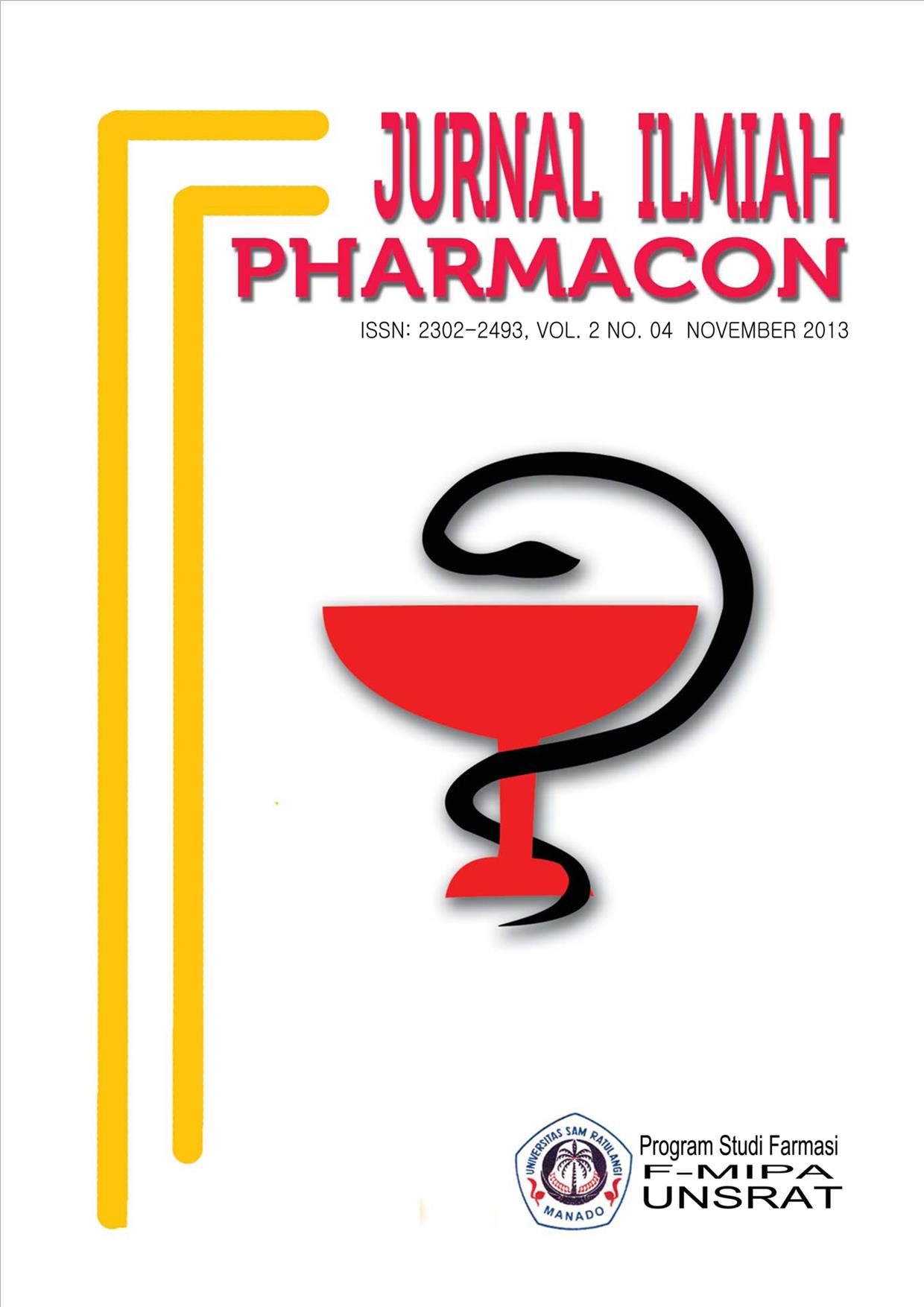UJI EFEKTIVITAS EKSTRAK ETANOL RAMBUT JAGUNG (Zea mays L.) TERHADAP PENURUNAN KADAR GULA DARAH TIKUS PUTIH JANTAN GALUR WISTAR (Rattus norvegicus L.) YANG DIINDUKSI ALOKSAN
DOI:
https://doi.org/10.35799/pha.4.2015.8835Abstract
UJI EFEKTIVITAS EKSTRAK ETANOL RAMBUT JAGUNG (Zea mays L.) TERHADAP PENURUNAN KADAR GULA DARAH TIKUS PUTIH JANTAN GALUR WISTAR (Rattus norvegicus L.) YANG DIINDUKSI ALOKSAN
Â
Kristover Koloay1), Gayatri Citraningtyas1), Â Widya Astuty Lolo1)
1)Program Studi Farmasi FMIPA UNSRAT Manado, 95115
Â
Â
ABSTRACT
Â
Hair corn (Zea mays L.) is a plant that has been known to lowering blood glucose level, but it has not been proved experimentally. This study aims to test the effectiveness of the ethanol extract of hair corn to lowering blood glucose levels white male rats strain Wistar induced alloxan. This study design is randomized experimental design, using white male rats strain Wistar (Rattus norvegicus L.) were made hyperglycemia using alloxan 130 mg/kgBB intraperitoneally. The sample consisted of 15 rats were divided 5 groups. A positive control group (glibenclamide 0,63 mg/kg), group B as a negative control (aquadest), group C (hair corn extract 0,63 g/KgBW), group D (hair corn extract 1,26 g/kg) and group E (hair corn extract 2,52 g/KgBW). The treatment was given once for two weeks. Data were analyzed using SPSS, significant difference between treatments was tested by one-way ANOVA followed by LSD to see significant differences between each treatment group. The results showed that the hair corn extract has the effect of lowering glucose level and the most effective dose is 2,52 g/KgBW. This study showed that the extract of hair corn (Zea mays L.) has the effect of lowering blood glucose levels in white male rats strain Wistar (Rattus norvegicus L.) induced by alloxan.
Â
Key words : Zea mays L., hyperglycemia, alloxan, Rattus norvegicus L.
Â
ABSTRAK
Â
Rambut jagung (Zea mays L.) merupakan tanaman yang telah diketahui mampu menurunkan kadar gula darah, namun belum dibuktikan secara eksperimental. Penelitian ini bertujuan untuk menguji efektivitas dari ekstrak etanol rambut jagung terhadap penurunan kadar gula darah tikus putih jantan galur wistar yang diinduksi aloksan. Desain penelitian ini adalah eksperimental dengan rancangan acak, menggunakan tikus putih jantan galur wistar (Rattus norvegicus L.) yang dibuat hiperglikemia menggunakan aloksan 130 mg/KgBB secara intraperitoneal. Sampel terdiri dari 15 ekor tikus yang dibagi 5 kelompok. Kelompok A sebagai kontrol positif (glibenklamid 0,63 mg/KgBB), kelompok B sebagai kontrol negatif (akuades), kelompok C (ekstrak rambut jagung 0,63 g/KgBB), kelompok D (ekstrak rambut jagung 1,26 g/KgBB) dan kelompok E (ekstrak rambut jagung 2,52 g/KgBB). Data di analisis menggunakan program SPSS, beda nyata antar perlakuan diuji dengan one way ANOVA dan dilanjutkan dengan LSD untuk melihat perbedaan signifikan antar setiap kelompok perlakuan. Hasil penelitian menunjukkan bahwa ekstrak rambut jagung memiliki efek menurunkan kadar gula darah dan dosis yang paling efektif ialah 2,52 g/KgBB. Penelitian ini menunjukkan bahwa ekstrak rambut jagung (Zea mays L.) memiliki efek menurunkan kadar gula darah pada tikus putih jantan galur wistar (Rattus norvegicus L.) yang diinduksi aloksan.
Â
Kata kunci : Zea mays L., hiperglikemia, aloksan, Rattus norvegicus L.
Downloads
Published
How to Cite
Issue
Section
License
Authors who publish with this journal agree to the following terms:
- Authors retain copyright and grant the journal right of first publication with the work simultaneously licensed under a Creative Commons Attribution-NonCommercial 4.0 International License that allows others to share the work with an acknowledgement of the work's authorship and initial publication in this journal.
- Authors are permitted and encouraged to post their work online (e.g., in institutional repositories or on their website) prior to and during the submission process, as it can lead to productive exchanges, as well as earlier and greater citation of published work (See The Effect of Open Access)










